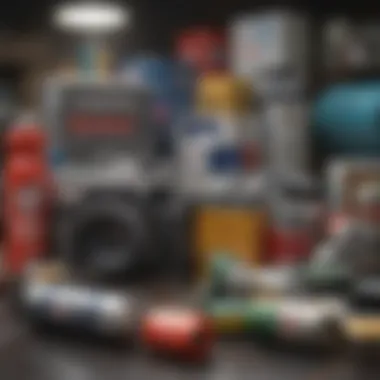Understanding Household Hazardous Waste Management


Overview of the Topic
Household hazardous waste (HHW) consists of materials commonly found in homes that can be harmful to health and the environment. This waste typically includes items like paint, batteries, pesticides, and cleaning products. Understanding this complex issue is essential for protecting both public health and the environment. The disposal of these materials is not just a personal responsibility; it is a community concern that necessitates informed practices and resources for effective management.
Proper identification and management of HHW have significant implications. The incorrect disposal of such materials can lead to soil and water contamination, which directly affects ecosystems and human populations. Moreover, awareness of this issue in society can prompt changes in behavior towards safer disposal and more sustainable practices.
Current Status and Challenges
Currently, many households are unaware of the potential dangers posed by HHW. This lack of knowledge leads to improper disposal methods, such as throwing these waste items in regular trash or down the drain. Consequently, the environment is put at risk, as many of these substances are toxic and can leach into the ground or waterways.
One key challenge is the inconsistency in regulations across different municipalities. Some areas lack proper facilities for HHW disposal. This variance creates a confusing landscape for residents. Additionally, there is limited public education about the risks of HHW and the proper disposal methods, which exacerbates the problem.
Sustainable Solutions
To address these challenges, communities can adopt several sustainable practices. First, local governments should enhance public education campaigns on the proper identification and disposal of hazardous waste. This includes providing clear guidelines and resources for residents.
Moreover, establishing drop-off centers specifically for HHW can provide citizens with convenient options. Successful examples exist in cities where hazardous waste collection events, often held annually, have promoted community engagement and lowered the incidence of improper disposal.
Examples of effective resource management include:
- City of San Francisco: Regular community outreach coupled with accessible HHW disposal sites has reduced hazardous waste in landfills.
- Seattle’s Home Hazardous Waste Program: This program has successfully integrated education and collection efforts, decreasing the overall hazardous waste generated.
Impact and Importance
The impact of managing HHW responsibly cannot be overstated. Improper disposal threatens ecosystems, wildlife, and human health. Contaminated soil and water can lead to long-term consequences, such as decreased biodiversity and health risks for the community.
Furthermore, implementing solid HHW management practices contributes to a sustainable future. The emphasis must be placed on conservation efforts and responsible resource use. Encouraging individuals and communities to engage in sustainable practices fosters a culture of accountability and responsibility towards future generations.
"The health of our environment is intertwined with the decisions we make in our households and communities. Proper management of household waste is a critical step toward sustainability."
Foreword to Household Hazardous Waste
Understanding household hazardous waste (HHW) is crucial in today's environmental context. The improper disposal of these materials poses significant risks to public health and the environment. This section lays the groundwork for why addressing this issue matters. Many households unknowingly accumulate hazardous items, creating potential dangers. Cleaning products, electronics, and batteries are a just a few examples. Recognizing HHW is the first step in mitigating risks.
The impact of HHW goes beyond individual households. Proper management of these materials can prevent contamination of soil and water supplies. This is where community knowledge and action play a pivotal role. Individuals can contribute to environmental protection by understanding their hazardous waste and participating in disposal programs.
In addition, being informed allows consumers to make better choices about products. This means selecting alternatives that are less harmful.
Defining Household Hazardous Waste
Household hazardous waste refers to waste generated in homes that poses a risk to health or the environment. It includes a variety of materials, such as chemicals and cleaners, that, when improperly managed, can leak into the environment. These materials often contain toxic substances that, when released, can endanger the ecosystem and human health.
To be classified as hazardous, the waste must exhibit certain characteristics: toxicity, ignitability, corrosivity, or reactivity. Knowing these characteristics aids individuals in identifying potentially hazardous items in their homes.
Common Types of Household Hazardous Waste
Identifying the common types of household hazardous waste is essential for managing and disposing of these materials safely. Below are some of the main categories:
Chemicals and Cleaners
Chemicals and cleaners are prevalent in household settings. Products such as bleach, drain cleaners, and aerosols fall into this category. Their key characteristic is their ability to clean and disinfect. However, the harsh chemicals can irritate the skin, eyes, and respiratory system. This risk highlights the importance of using them cautiously. In this article, we emphasize the need for eco-friendly cleaning alternatives to reduce exposure to harmful substances.
Electronics
Electronics, including old computers and televisions, contain hazardous elements like lead and mercury. These materials can pollute the environment if thrown away improperly. The key characteristic of electronics is their fast obsolescence, causing many to become waste within a short period. This makes it vital for consumers to find proper disposal methods, like local e-waste recycling centers, to prevent material release into the environment.
Paints and Solvents
Paints and solvents are common in many households, often used for home improvements. The unique feature is that they contain volatile organic compounds (VOCs) which can evaporate and contribute to air pollution. While they serve essential functions in maintenance, understanding their disposal is critical as improper disposal can lead to environmental contamination. We explore safer products and disposal practices in this article to mitigate the risks involved.


Batteries
Batteries are often overlooked when it comes to hazardous waste. They contain heavy metals and corrosive materials that can drip into soil and water supplies. Their key characteristic—energy storage—makes them widely used in many devices. However, their hazardous nature necessitates specific disposal methods. Proper recycling programs can reduce their negative environmental impact, which we will discuss in detail.
Pesticides and Herbicides
Pesticides and herbicides are designed to control pests, yet they are also hazardous if mismanaged. The unique feature of these products is their toxic effectiveness. These chemicals can leach into soil and waterways if disposed of improperly. This poses a risk not only to ecological health but also to human safety. We address safer alternatives in this article to reduce reliance on harmful chemicals, fostering a healthier environment.
Health and Environmental Risks
Understanding the health and environmental risks associated with household hazardous waste (HHW) is critical for effective management and protection of public health. HHW contains substances that pose considerable risks to both human health and the environment. By addressing these risks, individuals and communities can make informed decisions regarding storage, disposal, and alternatives to hazardous substances.
Adverse Health Effects of Exposure
Short-term Health Issues
Exposure to hazardous household waste can lead to immediate health concerns. Short-term health issues often manifest through symptoms such as headaches, dizziness, skin irritation, and respiratory problems. These symptoms occur due to direct contact with toxic materials or inhalation of harmful fumes. The key characteristic of these short-term effects is their acute nature; they typically arise soon after exposure and can cause significant discomfort. Understanding these effects is beneficial for raising awareness about proper handling of HHW. It serves as an alert for households to take precautions against improper storage and disposal. Moreover, recognizing these issues encourages prompt medical attention when symptoms occur, contributing to overall community health. However, one potential disadvantage is that many individuals may overlook these risks, believing them to be minor or temporary.
Long-term Health Risks
In contrast to short-term health issues, long-term health risks associated with HHW are often less visible but equally concerning. Prolonged exposure to hazardous substances can result in chronic diseases, including cancers, neurological disorders, and reproductive issues. The key characteristic of these long-term risks is their cumulative effect; health problems may develop over many years, making it difficult to connect them directly to earlier hazardous exposures. This chronic perspective is crucial as it highlights the importance of preventing exposure in the first place. Awareness of long-term health risks inspires individuals to prioritize safe practices in waste management. On the downside, the gradual nature of these risks can lead to complacency or inaction among some people, as the consequences are not immediately apparent.
Environmental Degradation
Soil Contamination
Soil contamination is one of the most direct environmental consequences of improper disposal of HHW. Hazardous materials can seep into the ground, affecting soil quality and potentially entering the food chain. The key characteristic of soil contamination is its long-lasting impact; once toxins are in the soil, remediation can be difficult and expensive. Understanding this issue is vital for enforcing responsible disposal practices and promoting eco-friendly alternatives. However, the challenge lies in the invisible nature of contamination; often, the effects are not evident until significant damage has already occurred.
Water Pollution
Water pollution occurs when hazardous waste leaches into groundwater or surface water bodies. This contamination can severely affect aquatic life and pose serious health risks to humans. The characteristic of water pollution in the HHW context lies in its widespread and often untraceable nature. Pollutants can travel vast distances, complicating efforts to identify sources. Recognizing the dangers of water pollution amplifies the need for community engagement and public policies aimed at improving waste management. Nonetheless, the complex nature of water systems makes mitigation efforts challenging and can lead to public frustration.
Air Quality Impact
Air quality can be significantly compromised by hazardous waste practices. Chemicals and fumes released into the atmosphere can lead to poor air quality and respiratory illnesses. The key characteristic of air quality impact is its immediacy; poor air quality can affect individuals in real-time, particularly vulnerable populations such as children and the elderly. It is essential to highlight this risk as it serves as a compelling reason for households to participate in proper waste management practices. However, similarly to other environmental impacts, the effects of air pollution are often abstract for individuals until personally experienced.
"Reducing household hazardous waste is not just a personal choice; it is a community obligation that enhances public health and environmental integrity."
In summary, comprehending health and environmental risks posed by household hazardous waste lays a foundation for responsible management practices. Awareness of short-term and long-term health effects encourages individuals to act proactively. Additionally, understanding environmental degradation through soil, water, and air is crucial for promoting sustainable community practices.
Legislation and Regulations
Legislation and regulations regarding household hazardous waste (HHW) are crucial for public health and environmental safety. These laws establish the framework for the management, disposal, and treatment of hazardous materials found in homes. Understanding these regulations allows households to follow safe disposal practices while also keeping the community informed about potential risks related to HHW. Regulations streamline the process of disposal, ensuring that hazardous materials do not harm individuals or the environment. The implications of these laws extend beyond mere compliance, influencing how communities engage in waste management practices sustainably.
Federal Regulations Governing HHW
Resource Conservation and Recovery Act
The Resource Conservation and Recovery Act (RCRA) is a vital piece of legislation. It governs the disposal of solid and hazardous waste across the United States. One of its primary contributions is the setting of standards for waste management practices. RCRA establishes a framework for managing hazardous waste from its creation through disposal.
A key characteristic of RCRA is that it emphasizes waste minimization and resource conservation. For this article, RCRA is advantageous because it not only manages disposal but also encourages the reduction of waste at the source. This proactive approach contributes significantly to reducing the amount of hazardous materials that reach landfills, thus benefiting both people and ecosystems.
A unique feature of RCRA is its regulation of hazardous waste generators. It categorizes them based on the quantity of waste they produce, which influences the regulatory requirements they face. However, a disadvantage can be the complexity of compliance, particularly for small businesses or households unaware of their obligations.
Emergency Planning and Community Right-to-Know Act
The Emergency Planning and Community Right-to-Know Act (EPCRA) plays an essential role in informing communities about hazardous substances. It facilitates emergency planning, ensuring that local governments prepare for potential chemical emergencies. The Act requires that information about hazardous chemicals is made accessible to the public. This transparency is a beneficial aspect of EPCRA, as it empowers individuals to understand the risks in their environment.
A notable characteristic of EPCRA is its focus on transparency and community involvement. By mandating the reporting of hazardous substances, communities become more proactive in addressing potential threats. This improves overall awareness of HHW issues and promotes safety at the community level.


The unique feature of EPCRA lies in its community right-to-know provisions, which promote public access to information on chemical risks. However, the challenge can arise from the varying levels of engagement among communities, leading to discrepancies in awareness and preparedness.
State-Level Regulations and Variations
State-level regulations can differ significantly concerning hazardous waste management. Variations may include stricter rules or alternative disposal methods depending on the specific regulations of each state. States often implement additional requirements based on local environmental concerns or public health needs.
Such diversity in state regulations can create confusion for residents. It demands that households understand and adhere to their particular state's guidelines, especially those that may be more stringent than federal laws. In many cases, local governments offer educational resources to help residents identify hazardous waste materials and proper disposal methods.
Household Practices for Hazardous Waste Management
Household practices for managing hazardous waste are crucial for reducing risks to both health and the environment. Understanding how to properly identify, store, and dispose of hazardous items can significantly mitigate the dangers associated with these materials. By adopting good practices, individuals can contribute to safer communities and a healthier planet.
Identification of Hazardous Items at Home
Identifying hazardous items in the home is the first step towards effective management. Many common products may contain harmful substances. Some often-overlooked items include household cleaners, batteries, and certain types of paint.
To accurately identify these materials, individuals should:
- Read labels carefully for signal words like "toxic," "flammable," or "corrosive."
- Keep an inventory of items used regularly around the house.
- Research products that are commonly known to pose risks, such as pesticides and electronic waste.
Awareness of the hazardous nature of certain household items is necessary. This understanding helps in recognizing potential dangers and taking appropriate action.
Safe Storage and Labeling
Proper storage and labeling of hazardous materials is essential for safety. Household hazardous waste should be stored away from living areas and in a secure place to avoid accidental exposure, especially for children and pets. Here are key considerations for safe storage:
- Use original containers: Keeping products in their original containers preserves labeling and reduces the risk of mixing incompatible substances.
- Label containers: Clear labeling serves as a reminder of the product's nature and proper handling instructions.
- Temperature control: Ideally, store hazardous waste in a cool, dry place to prevent chemical reactions or degradation.
Adopting these storage practices ensures that hazardous materials are kept safe and accessible when needed, reducing the likelihood of accidents.
Alternatives to Hazardous Products
Finding alternatives to hazardous products can help reduce the amount of toxic material entering households. By opting for safer solutions, individuals can accomplish the same tasks without the associated risks.
Eco-Friendly Cleaning Products
Eco-friendly cleaning products have gained popularity as effective alternatives to traditional cleaners. Their key characteristic is that they are made with naturally derived ingredients, significantly reducing toxicity levels.
The unique feature of eco-friendly cleaners is their ability to clean without harsh chemicals. They often use components like vinegar or baking soda. The advantages include:
- Reduced health risks: These products often lack the adverse health effects linked to conventional cleaners, making them safer for family use.
- Environmental safety: Biodegradable ingredients contribute less to pollution.
- Versatility: Many can serve multiple cleaning purposes, reducing the need for numerous chemicals.
However, a disadvantage can be their cost, although many consumers find the added health benefits worth the expense.
Natural Pest Control Solutions
Natural pest control solutions are another excellent alternative. Many common methods involve ingredients from nature that effectively deter pests without toxic chemicals. Their characteristic is reliance on non-synthetic substances.
These solutions often feature features like essential oils or soap-based products. Advantages include:
- Safety for humans and pets: These methods are less harmful than conventional pesticides.
- Sustainability: They minimize the impact on ecosystems.
- Less waste: Many natural solutions can be made from leftover kitchen items, reducing waste.
Disadvantages may include effectiveness time, as they often require repeated applications compared to chemical solutions.
Understanding and applying safe practices for household hazardous waste management can lead to a more sustainable living environment.
Disposal Methods and Resources
Proper disposal of household hazardous waste (HHW) plays a critical role in environmental conservation and public health. All individuals should recognize the potential dangers of improper disposal. The lack of knowledge or awareness regarding the correct methods can lead to health risks for both humans and the surrounding ecosystem. Knowing the resources available for responsible disposal can simplify management and encourage better practices.


Local HHW Collection Programs
Local HHW collection programs are essential for safely managing hazardous materials. Many communities operate such programs to allow residents to drop off their hazardous wastes. This approach not only ensures that hazardous materials are handled correctly but also serves to educate the public about the risks associated with HHW.
These programs often have scheduled collection days and designated drop-off locations. Participating in them reduces the likelihood of toxic chemicals entering landfills or the environment. It is also advisable to check with local authorities for any specific regulations or requirements. Some municipalities publish guides that detail what can be accepted, which results may vary depending on location.
Drop-off Locations and Events
In addition to local collection programs, many governments and organizations organize special drop-off events. These events provide an opportunity for households to dispose of hazardous materials conveniently and safely. Such gatherings often occur during Earth Day or other environmental awareness campaigns.
Individuals should locate these events ahead of time, as they may not be held frequently. Knowing where and when to go is key. One should routinely check local government websites or community boards for announcements regarding these events.
Event guidelines usually include the types of materials that can be accepted. Ensuring compliance helps streamline the process while keeping the event safe. Participating in these events often fosters a sense of community responsibility.
Mail-In Disposal Programs
For those living in areas where local drop-off options are limited, mail-in disposal programs present a viable alternative. These programs often appeal to individuals who prefer not to transport hazardous waste themselves. Many are operated by specialized companies that have established safe handling procedures specifically for hazardous materials.
Residents can order disposal kits that combine appropriate packaging materials with instructions for mailing hazardous items. The simplicity of receiving a kit at home, filling it, and mailing it away makes this option attractive. However, participants must ensure that the materials being sent are compliant with postal regulations. Thorough review of the mail-in guidelines is important to avoid complications. While this option often incurs a fee, it provides a hassle-free approach to ensure responsible disposal.
Effective disposal methods for HHW safeguard the environment and public health. Each option discussed encourages better practices as we adapt to lifestyle changes.
To summarize, understanding available disposal methods and resources helps households manage hazardous waste more effectively. By utilizing local collection programs, participating in drop-off events, or employing mail-in disposal methods, individuals can minimize potential dangers associated with HHW.
Community Engagement and Education
Community engagement and education are critical in addressing the issue of household hazardous waste (HHW). These elements empower individuals and families to understand the risks associated with HHW and the strategies for proper management. Through collaborative efforts, communities can elevate awareness, leading to safer disposal practices that benefit both public health and the environment.
Raising Awareness on HHW Issues
Community Workshops
Community workshops serve as a significant platform for disseminating information about HHW. They are typically interactive, allowing participants to engage in discussions and hands-on activities. One key characteristic of these workshops is their focus on practical knowledge. They provide real-life examples, emphasizing the dangers of improper disposal and common hazards in homes.
The popularity of community workshops stems from their ability to foster a sense of community and shared responsibility. These events encourage individuals to connect and discuss local issues while learning effective waste management strategies. A unique feature of community workshops is that they can be tailored to specific demographics, ensuring that content is relevant and accessible. The advantages of these workshops include enhancing local knowledge and creating a network of informed citizens.
However, there are disadvantages too. Not everyone may feel comfortable attending or participating in these sessions. Additionally, the effectiveness can vary based on attendance and engagement levels.
School Educational Programs
School educational programs represent another essential aspect of raising awareness regarding HHW. These programs often target younger generations, instilling safe practices early on. A key characteristic of school programs is their ability to incorporate environmental education into existing curricula, making it easier for students to learn about sustainability.
School programs are beneficial as they encourage students to think critically about the products they use at home and the consequences of their disposal methods. Moreover, these programs often include hands-on activities or projects, which help reinforce learning. A unique feature is their potential for long-term impact; as students share knowledge with family and friends, the reach of the programs extends beyond classrooms into households.
Nevertheless, the reliance on school curriculums may limit flexibility in addressing urgent local HHW issues. Additionally, varying levels of commitment from schools can impact program effectiveness.
Encouraging Responsible Disposal Practices
Encouraging responsible disposal practices is essential in reducing the risks associated with HHW. Organizations can implement campaigns to promote proper disposal methods. Local governments, environmental groups, and educational institutions play vital roles in this effort. Establishing clear guidelines and providing resources can increase compliance and enhance community health.
Organizations can create informative materials alongside community events to facilitate this learning process. They can also integrate social media, allowing for increased awareness and outreach. This multifaceted approach positions individuals to make informed decisions, actively contributing to a healthier environment.
Closure
The conclusion of this article serves as a crucial element in reinforcing the importance of understanding household hazardous waste (HHW). It acts as a summation of the key insights discussed throughout the text, highlighting why awareness and proper management of HHW is essential for both individual households and our broader communities. By synthesizing the gathered information, the conclusion emphasizes the dual benefits of health protection and environmental conservation.
Summary of Key Points
To encapsulate the primary themes, it is important to recall the following key points:
- Definition and Types: Household hazardous waste encompasses various materials that pose threats to health and environment. Common types include chemicals, electronics, paints, batteries, and pesticides.
- Health Risks: Exposure to HHW can lead to serious health issues, both immediate and long-term, ranging from respiratory problems to cancer.
- Environmental Impact: Improper disposal of HHW degrades soil and water quality while contributing to air pollution.
- Regulatory Framework: Both federal and state regulations exist to oversee the safe management of these materials.
- Community Engagement: Education and community programs play a vital role in raising awareness about safe practices and disposal options.
Call to Action for Households and Communities
Encouraging responsible practices regarding HHW is necessary. Individuals and communities alike must take actionable steps:
- Identify Hazardous Waste: Households should evaluate their own spaces for hazardous materials that require special attention.
- Participate in Local Programs: Engage with local HHW collection programs and participate actively in disposal events.
- Educate Others: Share knowledge about HHW among friends, family, and neighbors to create a ripple effect of awareness and responsible behavior.



